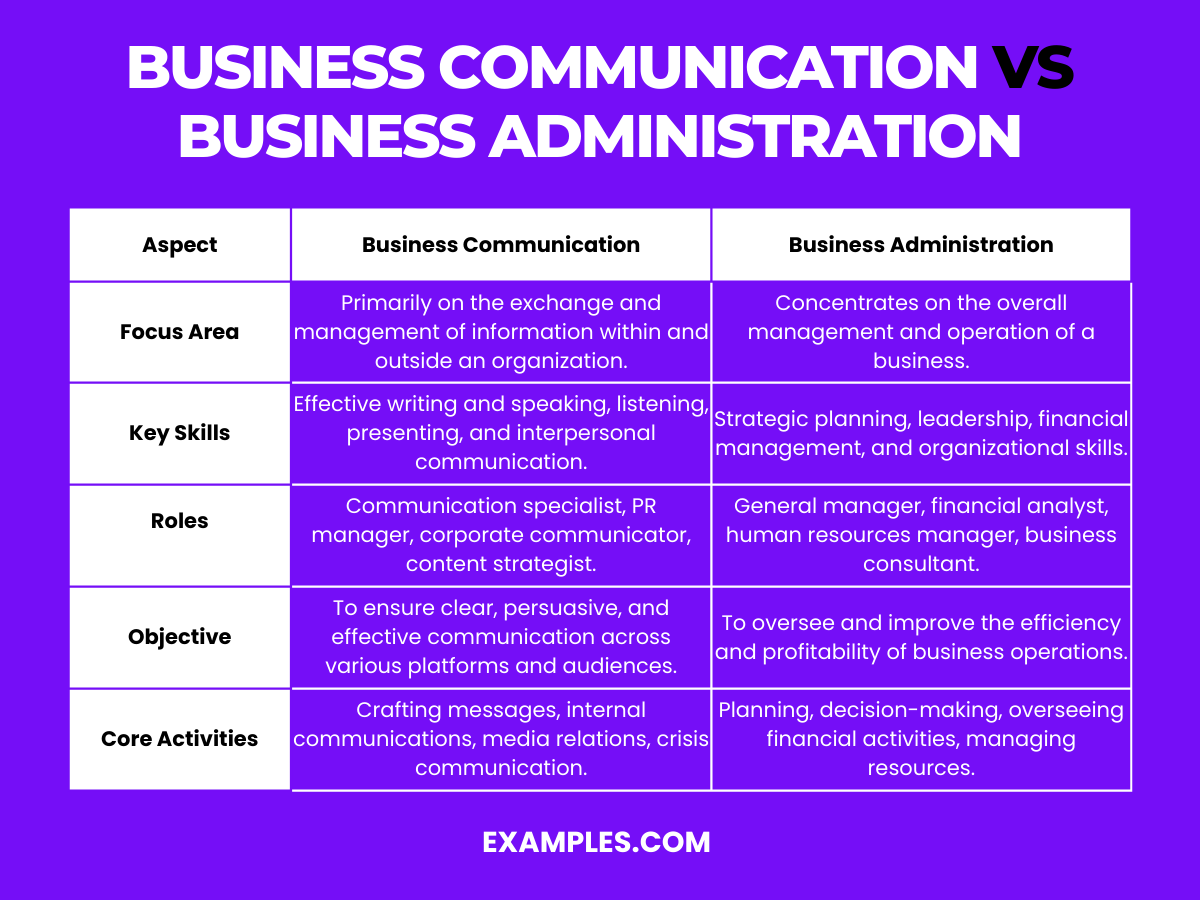Business Communication vs Business Administration
Navigating the realms of Business Communication and Business Administration can be a complex but rewarding journey. This comprehensive guide offers a detailed comparison, enriched with practical communication examples, to illuminate the unique aspects and overlapping elements of these two critical business sectors. By providing real-world scenarios and examples, we aim to help professionals and students alike understand the distinct roles, skills, and career paths in both fields, ultimately guiding them towards making informed decisions about their professional futures.
Download Business Communication PDF
Download Business Administration PDF
Difference Between Business Communication and Business Administration
The fields of Business Communication and Business Administration, though interrelated, focus on different aspects of business operations. Understanding their distinctions is crucial for those navigating the corporate world. Here’s a comparative table to clearly outline these differences:
| Aspect | Business Communication | Business Administration |
|---|---|---|
| Focus Area | Primarily on the exchange and management of information within and outside an organization. | Concentrates on the overall management and operation of a business. |
| Key Skills | Effective writing and speaking, listening, presenting, and interpersonal communication. | Strategic planning, leadership, financial management, and organizational skills. |
| Roles | Communication specialist, PR manager, corporate communicator, content strategist. | General manager, financial analyst, human resources manager, business consultant. |
| Objective | To ensure clear, persuasive, and effective communication across various platforms and audiences. | To oversee and improve the efficiency and profitability of business operations. |
| Core Activities | Crafting messages, internal communications, media relations, crisis communication. | Planning, decision-making, overseeing financial activities, managing resources. |
| Outcomes | Enhanced internal and external relationships, effective message dissemination, improved brand image. | Increased operational efficiency, profitability, improved organizational structure, strategic growth. |
This table provides a snapshot of the fundamental differences between Business Communication and Business Administration, each playing a distinct yet complementary role in the corporate ecosystem.
10 Business Communication Examples
Business Communication is pivotal in ensuring efficient and effective operations within an organization. It encompasses various forms, from digital correspondence to interpersonal interactions, each vital for maintaining clear and productive communication channels. Understanding these examples, their causes, and remedies is key for any thriving business environment.
- Emails: Common for quick information exchange; can lead to misunderstandings due to lack of tone. Fix by being clear and concise.
- Meetings: Essential for team discussions; ineffective if poorly structured. Ensure a clear agenda and objectives.
- Presentations: Used for pitching ideas; can be ineffective if not engaging. Utilize visual aids and storytelling.
- Reports: Provide detailed information; can be overlooked if too lengthy. Summarize key points for clarity.
- Newsletters: Keep staff updated; lack of interest if content is not relevant. Tailor content to audience needs.
- Social Media Posts: Enhance brand image; misinterpretation can occur. Use clear, audience-appropriate language.
- Video Conferences: Connect remote teams; technical issues can hinder communication. Regular checks and backups are essential.
- Phone Calls: Offer immediate interaction; can lead to miscommunication. Follow up with written summaries.
- Feedback Sessions: Important for growth; can be taken negatively. Provide constructive, balanced feedback.
- Corporate Events: Strengthen team bonds; lack of engagement if not well-organized. Plan with clear objectives and interactive elements.
10 Business Administration Examples
Business Administration encompasses a broad range of activities essential for the smooth operation and success of any organization. It involves strategic planning, resource management, and decision-making to ensure organizational goals are met efficiently. Understanding various examples of business administration, their causes, and solutions is crucial for effective management and organizational success.
- Strategic Planning: Essential for setting goals; lack of direction can cause failure. Remedy by developing clear, actionable plans.
- Financial Management: Involves budgeting and accounting; poor financial planning leads to losses. Fix with regular audits and adjustments.
- Human Resources Management: Key for staff well-being; ineffective HR leads to high turnover. Improve by implementing employee-centric policies.
- Project Management: Coordinates activities towards a goal; poor management causes delays. Use effective tools and methodologies.
- Supply Chain Management: Ensures smooth product flow; disruptions can impact operations. Mitigate with contingency planning.
- Customer Relationship Management (CRM): Builds customer loyalty; neglect can lead to dissatisfaction. Enhance by regular engagement and feedback.
- Risk Management: Identifies and mitigates risks; overlooked risks can be disastrous. Conduct regular risk assessments.
- Quality Control: Maintains product/service standards; poor quality affects reputation. Implement rigorous testing procedures.
- Inventory Management: Balances supply and demand; mismanagement leads to stock issues. Use predictive analytics for better forecasting.
- Compliance Management: Ensures adherence to laws; non-compliance can result in penalties. Stay updated with regulatory changes.
Comparison Between Business Communication and Business Administration
In the corporate world, understanding the nuances between Business Communication and Business Administration is crucial. Both fields play pivotal roles in the success and smooth functioning of an organization, yet they focus on different aspects of business operations. This guide offers a detailed comparison, shedding light on how these two vital business areas differ and intersect.
Core Focus
- Business Communication: This field revolves around the effective exchange and management of information within and across organizations. It aims to facilitate clear, persuasive, and impactful communication.
- Business Administration: This area focuses on the holistic management and oversight of business operations, including planning, organizing, staffing, directing, and controlling an organization.
Key Responsibilities
- Business Communication: Professionals are responsible for crafting internal and external communications, managing public relations, developing communication strategies, and ensuring message clarity and engagement.
- Business Administration: Here, the focus is on strategic decision-making, financial management, resource allocation, operational efficiency, and overall business planning.
Skill Sets
- Business Communication: Requires strong written and verbal communication skills, active listening, empathy, adaptability, and an understanding of digital communication platforms.
- Business Administration: Demands strategic thinking, leadership qualities, analytical skills, financial acumen, and a deep understanding of market dynamics.
Career Paths
- Business Communication: Offers roles such as Communications Manager, PR Specialist, Corporate Communicator, and Media Relations Manager.
- Business Administration: Leads to positions like Business Manager, Financial Analyst, HR Manager, and Operations Director.
Educational Requirements
- Business Communication: Typically requires a degree in communications, journalism, or related fields, emphasizing media studies and corporate communication.
- Business Administration: Usually involves a degree in business administration or management, focusing on finance, marketing, and strategic management.
Industry Impact
- Business Communication: Plays a crucial role in brand building, reputation management, employee engagement, and customer relationships.
- Business Administration: Directly affects an organization’s profitability, operational efficiency, market position, and long-term strategic goals.
Challenges and Solutions
- Business Communication: Challenges include navigating cultural differences, technological advancements, and maintaining message consistency. Solutions involve continuous learning, embracing diverse communication mediums, and fostering an inclusive communication culture.
- Business Administration: Encounters challenges like market volatility, regulatory changes, and resource management. Overcoming these requires adaptive strategy, financial prudence, and innovative management practices.
Understanding these differences and how they complement each other is essential for anyone looking to advance their career in either field. Both Business Communication and Business Administration are integral to the functioning and success of modern organizations, each contributing uniquely to the corporate tapestry.
Relationship Between Business Communication and Business Administration
Understanding the interplay between Business Communication and Business Administration is key to grasping the full spectrum of organizational success. These two fields, while distinct in their focus, are deeply interconnected and mutually reinforcing. This comprehensive guide explores how Business Communication and Business Administration complement each other, creating a synergistic effect that drives business growth and efficiency.
Complementary Roles
- Information Flow and Decision Making: Business Communication ensures that vital information flows seamlessly across various departments, aiding the decision-making processes central to Business Administration.
- Strategy Implementation: Effective communication is crucial for implementing strategies devised by business administrators, ensuring everyone is aligned with the organization’s goals and objectives.
Impact on Organizational Culture
- Building a Cohesive Culture: Business Communication plays a crucial role in shaping and maintaining a positive organizational culture, which is fundamental for effective administration and management.
- Facilitating Change Management: In Business Administration, when introducing changes in processes or strategy, clear communication is essential to gain buy-in and minimize resistance among employees.
Enhancing Efficiency and Productivity
- Streamlining Operations: Clear communication protocols established by Business Communication professionals help business administrators in streamlining operations and improving overall efficiency.
- Feedback Loops: Regular and effective communication allows for continuous feedback, which is essential for business administrators to fine-tune strategies and operations.
Driving Business Growth
- Market Understanding: Business Communication professionals gather insights from market trends, customer feedback, and competitor analysis, which are crucial for business administrators in strategic planning.
- Brand and Reputation Management: The collaboration between communication and administration is vital in building and maintaining a strong brand reputation, directly impacting business growth.
Nurturing Client and Employee Relationships
- Client Engagement: Business Communication strategies enhance client relationships, which are fundamental for successful business administration.
- Employee Engagement: Effective internal communication increases employee engagement and satisfaction, leading to better performance and reduced turnover, a key concern of business administration.
Integrated Approach to Problem-Solving
- Crisis Management: In times of crisis, a coordinated approach between communication and administration is critical to manage the situation effectively and maintain organizational stability.
Educational Synergy
- Combined Learning: Professionals and students often benefit from learning both communication and administrative skills, as they are interdependent in real-world business scenarios.
In Conclusion, the article on “Business Communication vs Business Administration” from Examples.com comprehensively compares these two crucial business sectors. It outlines their distinct roles, skills, career paths, and how they interplay in a corporate environment. The article includes a detailed table comparing various aspects of both fields, such as focus areas, key skills, and objectives. Additionally, it provides real-world examples and scenarios to illustrate their differences and overlaps, aiming to guide professionals and students in their career choices.
For further insights into these fields, consider exploring educational resources from top universities or industry leaders. Two valuable resources are Husson University’s online blog on communications vs business and TheBestSchools.org’s guide on career opportunities in business administration and management. These links offer additional perspectives and in-depth information that can be beneficial for those interested in pursuing careers in these areas.



